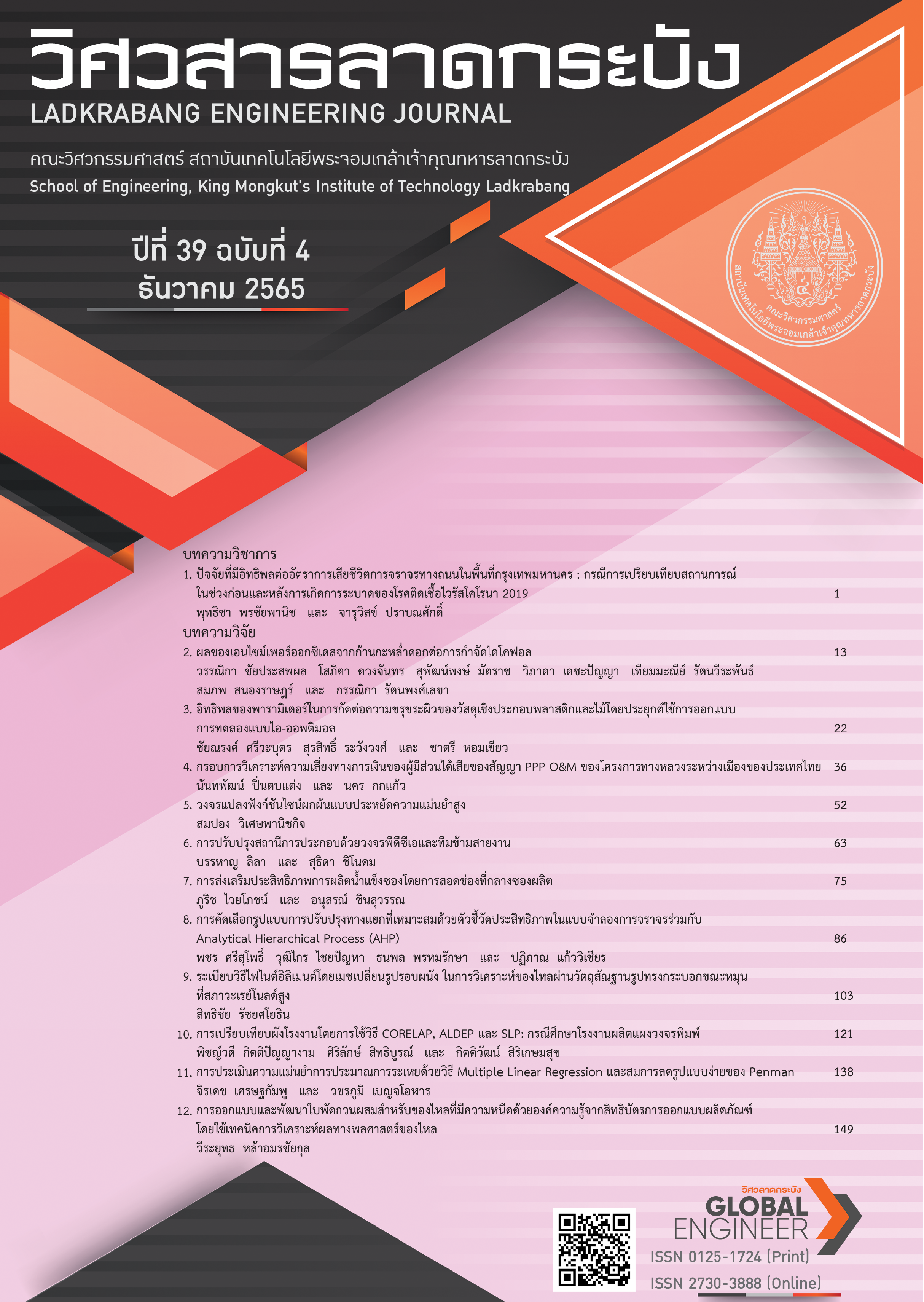ระเบียบวิธีไฟไนต์อิลิเมนต์โดยเมชเปลี่ยนรูปรอบผนัง ในการวิเคราะห์ของไหลผ่านวัตถุสัณฐานรูปทรงกระบอกขณะหมุนที่เลขเรย์โนลด์สูง
คำสำคัญ:
ไฟไนต์อิลิเมนต์ของไหลพลศาสตร์, ทรงกระบอกเซาะร่องและปลายดิสก์ที่หมุน, แบบจำลองการไหลปั่นป่วนบทคัดย่อ
การศึกษาเชิงคำนวณนี้นำเสนอพฤติกรรมการไหลภายนอกแบบปั่นป่วนผ่านวัตถุสัณฐานรูปทรงกระบอกที่หมุนในระบบแกน 3 มิติ ของเลขเรย์โนลด์ที่ 100,000 ถึงอัตราการหมุนไร้หน่วยที่ 2 วัตถุสัณฐานทรงกระบอกนี้มีลักษณะผนังเรียบและเซาะร่อง อีกทั้งทรงกระบอกประกอบดิสก์ที่ปลายทั้งสอง โดยใช้แบบจำลองการไหลปั่นป่วนชนิด high Re k-e ซึ่งปริมาณความเค้นเรย์โนลด์มีความสัมพันธ์เชิงเส้นกับความเครียดเฉลี่ยของชั้นการไหลทำให้เกิดการแยกตัวกัน พฤติกรรมนี้มีผลก่อกำเนิดกระแสวนขึ้น รวมถึงใช้สมการมาตรฐานของความเร็วเป็นไปตามกฏลอการิทึมที่บริเวณชั้นย่อยเฉื่อยการไหลปั่นป่วนที่ผนัง ระเบียบวิธีไฟไนต์อิลิเมนต์ได้กำหนดเพื่อทำการดิสครีไทซ์ตัวแปรการไหลในสนามการคำนวณและรูปร่างเมชมีการเปลี่ยนรูปที่ผนังเซาะร่องตามช่วงเวลาและปรับความสมดุลการไหลต่อเนื่องสำหรับเมชที่ใกล้ผนังทรงกระบอก ผลการคำนวณได้ยืนยันความถูกต้องกับผลการทดลองก่อนหน้าทำให้ได้ข้อมูลระดับความคลาดเคลื่อนสัมพัทธ์ในการคำนวณและแนวโน้มของแรงพลศาสตร์ที่เกิดขึ้นนอกเหนือช่วงการทดลองของแต่ละวัตถุสัณฐานทรงกระบอก โดยพฤติกรรมที่เกิดขึ้นได้อธิบายผลจากลักษณะการกระจายตัวของขอบเขตชั้นของการไหลรอบผนัง อีกทั้งลักษณะสนามการไหลของฟลักซ์ที่เกิดขึ้น
References
G. Magnus, “Ueber die Abweichung der Geschosse, und: Ueber eine auffallende Erscheinung bei rotirenden Körpern,” annalen der physik, vol. 164, no. 1, pp. 1–29, 1853, doi: 10.1002/andp.18531640102.
ENERCON, “Enercon E-Ship 1: A wind-hybrid commercial cargo ship,” presented at 4th Conference on Ship Efficiency, Hamburg, Germany, Sep. 23–24, 2013, pp. 1–26.
C. Badalamenti, “On the Application of Rotating Cylinders to Micro Air Vehicles,” PhD. Thesis, School of Engineering and Mathematical Sciences, City University London, London, UK, 2010.
K. K. Pijush and M. C. Ira, “Boundary Layers and Related Topic,” in Fluid Mechanics, 3rd ed., San Diego, CA, USA: Elsevier, 2004, ch. 10, sec. 9, pp. 346-52.
E. G. Reid, “Tests of Rotating Cylinders,” NACA., Washington, DC, USA, Tech. Notes, 1924.
A. Thom, “Experiments on the Air Forces on Rotating Cylinders, Aeronautical Research Committee Reports and Memoranda,” Air Ministry, London, UK, Rep. no. 1623, Jan 1925.
B. R. Clayton, “BWEA Initiative on wind-assisted ship propulsion (WASP),” Journal of Wind Engineering and Industrial Aerodynamics, vol. 19, no. 1–3, pp. 251–276, 1985, doi: 10.1016/0167-6105(85)90064-9.
K. Aoki and T. Ito, “Flow Characteristics around a Rotating Cylinder,” in Proc. Schl. Eng. Tokai Univ., Tokyo, Japan, 2001, pp. 29–34.
S. Takayama and K. Aoki, “Flow characteristics around a rotating grooved circular cylinder with grooved of different depths,” Journal of Visualization, vol. 8, no. 4, pp. 295–303, 2005, doi: 10.1007/BF03181548.
T. J. Craft, H. Iacovides, and B. E. Launder, “Dynamic Performance of Flettner Rotors With and Without Thom Discs,” in TSFP7, Ottawa, Canada, Jan. 28–31, 2012, pp. 6C13–6C18 .
S. J. Karabelas, “Large Eddy Simulation of high-Reynolds number flow past a rotating cylinder,” International Journal of Heat and Fluid Flow, vol. 31, no. 4, pp. 518–527, 2010, doi: 10.1016/j.ijheatfluidflow.2010.02.010.
A. Travin, M. Shur, M. Strelets and P. Spalart, “Detached-Eddy Simulations Past a Circular Cylinder,” Flow, Turbulence and Combustion ., vol. 63, pp. 293–313, 2000, doi: 10.1023/A:1009901401183.
A. Elmiligui, K. Abdol-Hamid, S. Massey and S. Pao, “Numerical Study of Flow Past a Circular Cylinder Using RANS, Hybrid RANS /LES and PANS Formulations,” in 22nd Applied Aerodynamics Conference and Exhibit, Providence, RI, USA, Aug. 16–119, 2004, pp. 1–18.
S. Ruchayosyothin, P. Konglerd and S. Tamna, “The computational modelling in the prediction of flow past a rotating sphere at high Reynolds number,” Journal of Research and Applications in Mechanical Engineering , vol. 10, no. 1, 2022, Art. no. JRAME-22-10-005, doi: 10.14456/jrame.2022.5.
B. E. Launder and D. B. Spalding, “The numerical computation of turbulent flows,” Computer Methods in Applied Mechanics and Engineering, vol. 3, no. 2, pp. 269–289, 1974, doi: 10.1016/0045-7825(74)90029-2.
U. Piomelli, Large-eddy and direct simulation of turbulent flows, in: 9e conférence annuelle de la société Canadienne de CFD, Ontario, Canada, May 27–19, 2001, pp. 1–60.
S. Littmarck and F. Saeidi, “ About COMSOL.” COMSOL. Available: https://www.comsol.com/, (accessed Aug. 1, 2022).
P. R. Spalart and S. R. Allmaras, “One-Equatlon Turbulence Model for Aerodynamic Flows,” in 30th Aerospace Sciences Meeting and Exhibit, Reno,NV,USA, Jan. 6, 1992, pp.1–23, doi: 10.2514/6.1992-439.
S. Mittal and B. Kumar, “Flow past a rotating cylinder,” Journal of Fluid Mechanics, vol. 476, pp. 303–334, 2003, doi: 10.1017/S0022112002002938.
Downloads
เผยแพร่แล้ว
How to Cite
ฉบับ
บท
License
Copyright (c) 2022 คณะวิศวกรรมศาสตร์ สถาบันเทคโนโลยีพระจอมเกล้าเจ้าคุณทหาร

This work is licensed under a Creative Commons Attribution-NonCommercial-NoDerivatives 4.0 International License.
บทความที่ได้รับการตีพิมพ์เป็นลิขสิทธิ์ของคณะวิศวกรรมศาสตร์ สถาบันเทคโนโลยีพระจอมเกล้าเจ้าคุณทหารลาดกระบัง
ข้อความที่ปรากฏในบทความแต่ละเรื่องในวารสารวิชาการเล่มนี้เป็นความคิดเห็นส่วนตัวของผู้เขียนแต่ละท่านไม่เกี่ยวข้องกับสถาบันเทคโนโลยีพระจอมเกล้าเจ้าคุณทหารลาดกระบัง และคณาจารย์ท่านอื่นๆในสถาบันฯ แต่อย่างใด ความรับผิดชอบองค์ประกอบทั้งหมดของบทความแต่ละเรื่องเป็นของผู้เขียนแต่ละท่าน หากมีความผิดพลาดใดๆ ผู้เขียนแต่ละท่านจะรับผิดชอบบทความของตนเองแต่ผู้เดียว






